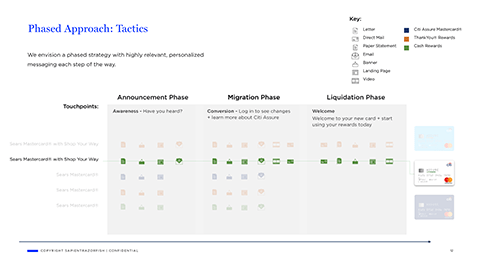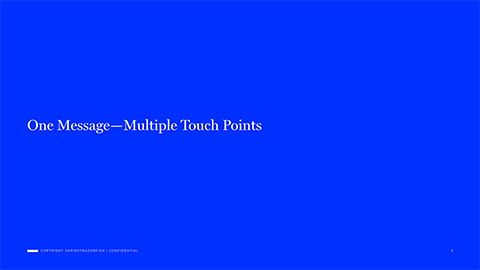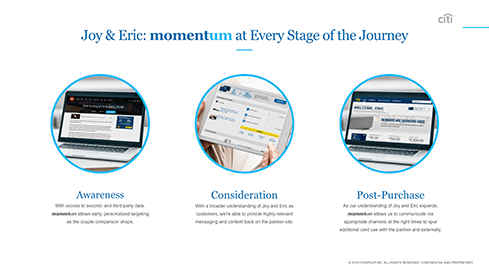Presentation Design
While the dialect is global, the medium by which business leaders is universal. Show, don’t tell. But preferably both. International conversations and meaningful business strategies emerge out of presentation decks, and we depend heavily on their ability to swiftly communicate complicated information and data.
Additionally, content and design choices play a major factor in how effectively those concepts are percieved and understood.
Below are a selection of presentations in which I played leading and/or major roles.
The Project: Greenlight
The Process: In the potential case of a massive business pivot, a new brand, new marketing, a new online presence, and coordinated D2C messaging via email, direct mail, and targeted advertising would all be a hairpin trigger-pull away. To make certain this effort would be successful, the assets, timing, themes, and playbook were already in the hopper, approved, and aligned to a plan every stakeholder felt was set up to succeed should that audible be called.
To do this, I and a handful of people in the creative department worked cross-functionally with UX, account, dev, budget, and client teams. It started my mapping out content strategy, coalescing around timing and budgets, determining what our deliverables were, and outlining the proposed G2M approach. Next, for the creative teams part, we built out timelines for deliverables, wired, designed, and acquired internal approvals for landing pages, media and relevant campaign designs, scripted, storyboarded, and produced video content, and assembled the deck outline and deck itself, as an inventory of our proposed solutions in the context of the broader strategy.
The Result: The audible was never called, and maybe the clear-eyed comfort and understanding of what that could look like helped inform whatever went into preventing that. Clients and contributors from associated roles, backgrounds, and experiences became aligned and poised for success before any emergency management situation came into play. We were all proud of the work and it informed much of what we did on other projects.going forward.
The Venue: Enhanced Presentation Setup
The Process: Whether working with a design team, or designing slides myself, step one is to align on content and visuals. Timelines are a factor and animations are “nice-to-haves.” Objective one is to get the content and design right. As a motion designer, getting from one visual, or slide, to the next is the challenge and the fun.
To do this, I prepare designs for After Effects import by organizing source material. In this case, it was bringing Figma files that weren’t in Illustrator into Illustrator and organizing and optimizing them. For the files that were already in Illustrator, I just organized and optimized. I then created precomps in After Effects that are what breaks out into individual slides in the final deck.
The Result: Audiences were impressed, made comments, and asked how the presentation was made. Depending on how you feel about PowerPoint, it ultimately led to more support requests on other decks. At the executive level, these sorts of stand-out moments generate requests for additional presentation design support.
The Project: Bask Bank Presentation Template
The Process: In the foundational weeks and months of Bask Bank’s brand-building efforts, our small team was working with a partner agency to build broad campaign material, cultivate influencer and media partnerships, establishing processes for the American Airlines partnership, and so much more. Among those efforts was communicating to external audiences, business, partners, vendors, and the leadership at Texas Capital Bank, the parent company of Bask Bank.
Presentation design cleanup was among my responsibilities as the sole internal designer at the fintech startup. Immediately, the disparate nature of slide design provided to me by accountants, economists, developers, executives, and others all working independently, meant I needed to reconcile fonts, images, charts, content, and everything that goes into a deck under one cohesive visual language.
That process was time-consuming and often came late in the game when each contributor began consolidating their slides into one place for the upcoming presentation, whatever that might be. The cleanup lift was daunting.
Working with the marketing director, I proposed crafting a template for the team that would help corral some of the wild stylistic diversions that emerged from SME contributors inside the organization.
The following are a handful of slide template examples.
The Result: The internal distribution of this deck did a few things. Because several of the major business leads at Bask were not necessarily design savvy, and more interested in getting the company off the ground, this deck helped immerse our internal business and tech leads in the brand as they were building their slides for decks used in presentations they were lining up. This template also helped build out the character of the brand. While a lot of that work was being done by a partner agency, collaboration with their team helped ensure we were singing from the same song sheet, and the brand was maturing in a way that made sense. And for me (and all the stakeholders who needed my support), this deck helped by dramatically cutting design time down by empowering teams to build their content in alignment with the look and feel with Bask Bank, and it made deck consolidations much faster and easier.
The Project: Marketing Roadshow
The Process: While partnered with Citi Retail Services, Razorfish designed and developed a white-label credit card account management platform. Synchrony Bank or Barclay’s. Citi partner brands like Home Depot, Macy’s and others trusted Citi to help securely help customers access self-service for their retail credit cards. It was a B2B platform for B2C use.
When initially built, the platform allowed brands to integrate marketing messages. For example, Best Buy might want to liquidate the previous years’ television models, so Razorfish would help integrate that marketing into the customer card management experience.
One massive overhaul we took on was to implement Google Ads. This would empower Citi, their retail partners, and Razorfish to connect more intelligently with audiences in more relevant ways. Using the data we were allowed to gather on users as well as relevant contextual information, cardholders would now see marketing that more closely related to their actual lives.
The deck played out in two major parts:
The first part quickly captured the current state and what will be phased out. It jumped right into what was coming and how and why the change is being made. A high-level description of what was happening with the Google Ads integration and how data would empower marketing was key to understanding the tools and their potential without getting too granular into the details. The second part told the stories of two families.
In the first story, the family’s broken refrigerator forced them into a time-condensed appliance replacement journey. Using browsing and credit score data, the new platform is able to hone in on models the family shows great interest in and present them with accurate financing offers that help them decide to purchase their new fridge in-store at Home Depot with a newly approved credit card. Subsequent billing emails and platform messaging build the brand relationship by helping them shop for Father’s Day and get the right grill for summer.
The second story follows another family upgrading their entertainment hub with their Best Buy credit card. Doing exhaustive comparison research helps Google Ads built a more comprehensive profile for the cardholders and at just the right time, they are presented with a promotional credit on top of a cash back offer that is too good to pass on. Through card servicing the family sees relevant pay-off incentives that lead to travel and subsequent upgrades for the home entertainment system.
This deck was designed to tell the story of how thoughtful messaging, delivered at the right time, can create more meaningful moments in the customer journey.
The Result: Designed to cover highly sophisticated technical processes as well as the human element, this deck successfully informed Citi and their retail partners that the opportunities to connect with their customers in more strategic, and mutually beneficial ways was here and something to get excited about. Citi’s retail partners and their vendors were now handed a tremendous, open-ended way to think about how any one message appeared for the customer during a very specific time when they are interacting with the brand.
This led to more focused and relevant marketing, the ability to implement more immersive media, removed ad clutter, elevated creative, and fostered stronger relationships with the brand.
In short, this was a big win for Razorfish, Citi, their retail partners, and the end user.













































































